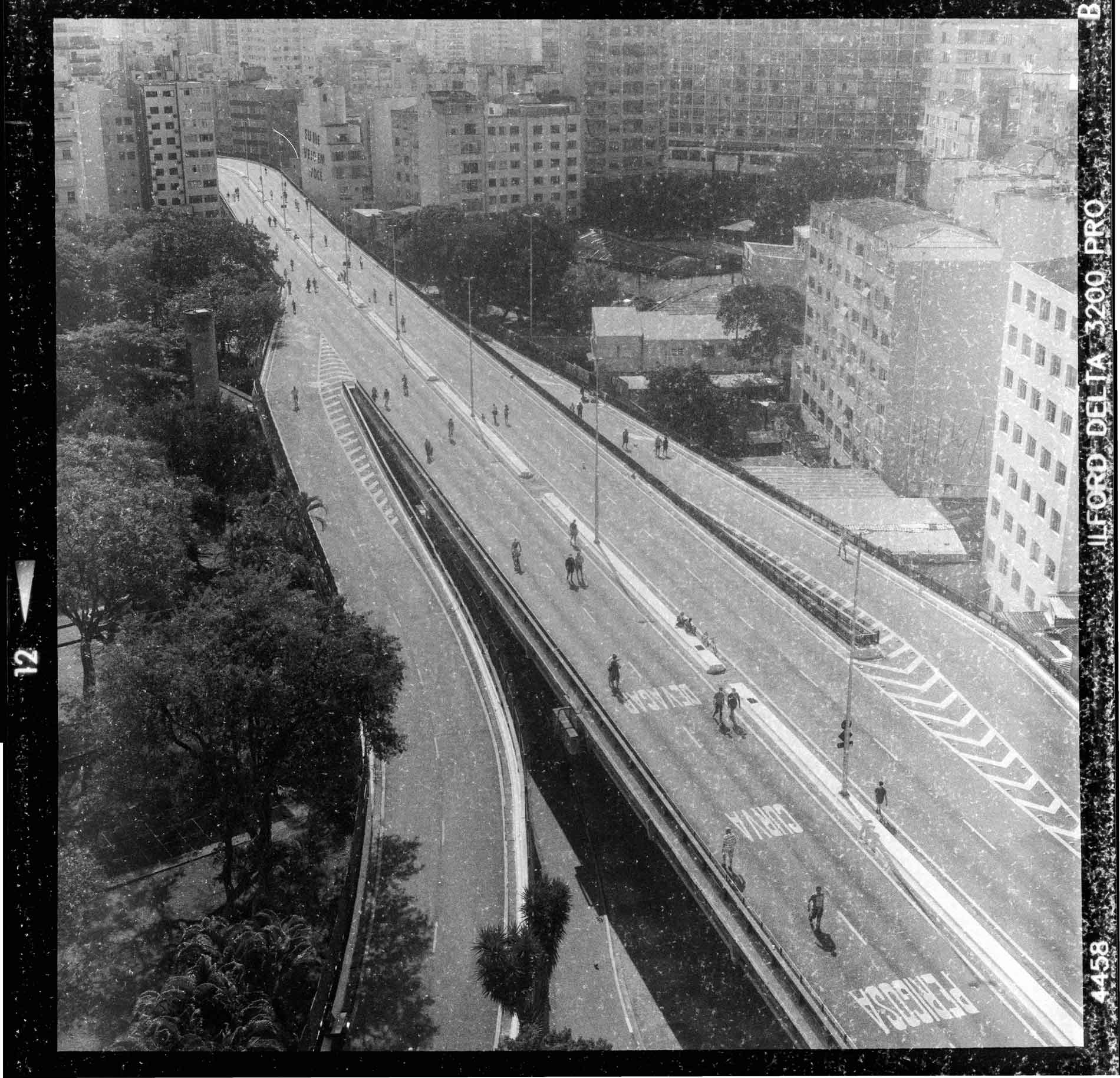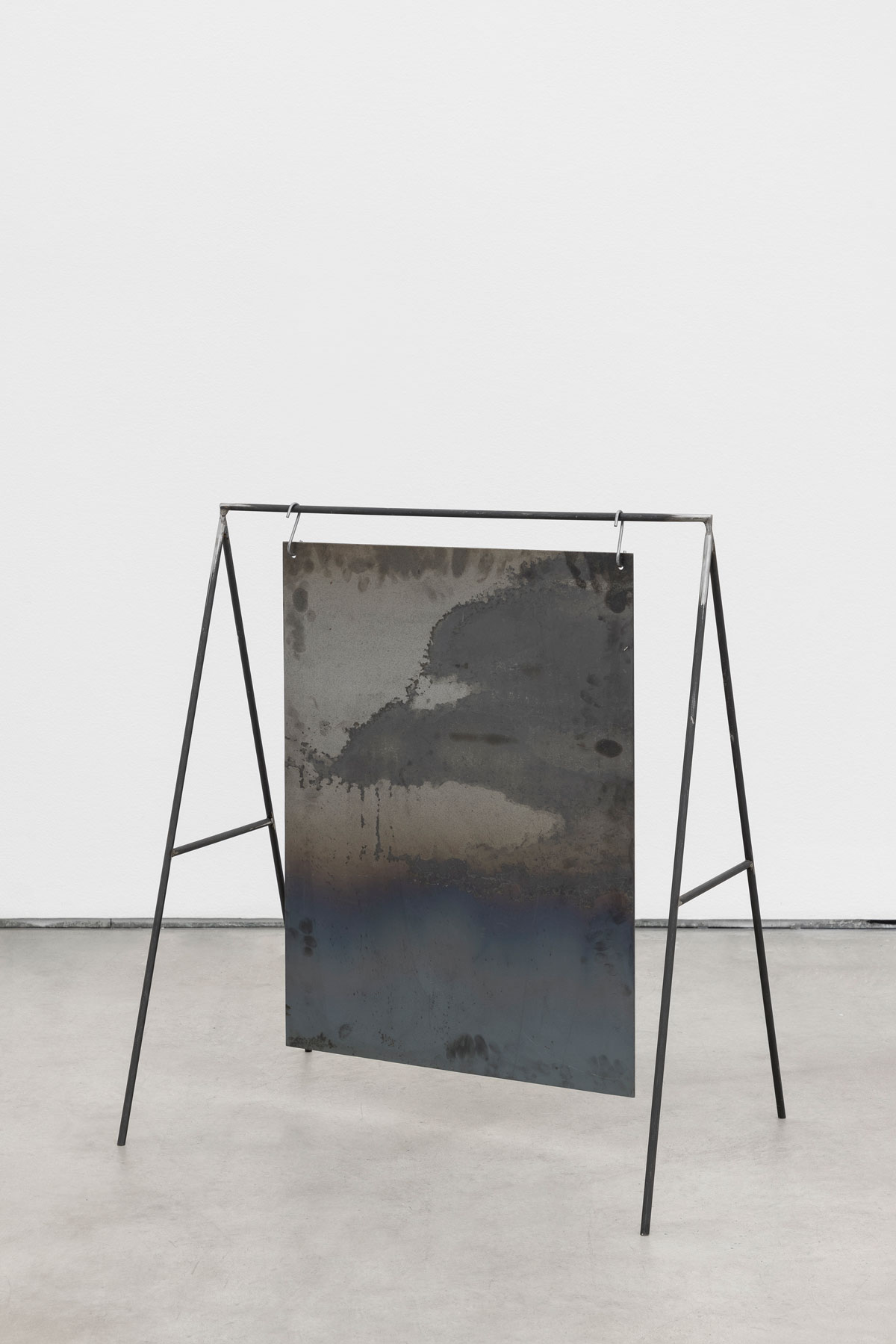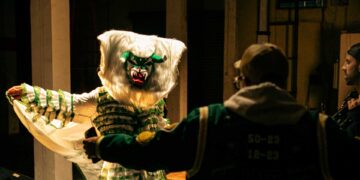Gustavo Delonero, Downtown São Paulo, view from Marcelo Cidade’s apartment, 2021.
Marcelo Cidade: We began (this conversation) by questioning what it would be like for an artist to think about architecture and for an architect to consider art. It would be interesting to explore another aspect where I view architecture as a form of art as well, which entails different practical considerations.
Gustavo Delonero: In the end, architecture can also be the place that represents power in the art system, right?
MC: It certainly can. Without architecture, art wouldn’t have a starting point. Can there truly be art without walls to hang a painting on? I believe every concept in Renaissance painting, indeed in painting overall, requires a foundation to be showcased. That’s where architecture steps in, from my standpoint, striving to uphold this human expression within some form of structure, whether it’s a canvas or a constructed framework. From my perspective, architecture originates from humanity’s necessity to craft a sheltered environment, to secure their existence amidst the wildness of nature.
GD: Yes. Paul Preciado has an interesting story that the possible origin of museums was in Pompeii (Italy), where artists drew scenes of nudity, sex, and humans having sexual relations with animals. These scenes were frozen in time by the eruption of Mount Vesuvius in 79 AD. In the 18th century, the city was founded by Christians, who didn’t want everyone to have access to those pagan images. So they began to control access to these images and objects, allowing only a few people and restricting access to women and children. It was known as the Secret Museum of Pompeii. A similar space existed for the ancient English collectors, where works taken from other cultures were exhibited in closed cycles, and only the “chosen” ones could enter.
MC: So, the idea of privatization already started back then.
GD: Yes, it’s about collecting spoils, appropriating materials from other cultures. It’s about possessing that object as if it now belongs to your collection. To own and have access to that “thing.”
MC: Indeed. It’s rather intriguing to consider that during the Renaissance, paintings served a purpose, almost embodying an idealized concept of a window. You gaze upon a scene depicted within this idealized perspective, as if peering out from within a space. Sometimes, the painting even suggested not merely overlapping with a window but offering the function of gazing at different locales beyond your immediate surroundings, don’t you think? It’s a form of escapism that I find incredibly fascinating.
GD: There’s a compelling essay by Hito Steyerl titled “In Free Fall: A (Thought Experiment) on Vertical Perspective,” where she talks about the concept of perspective in Renaissance paintings. Steyerl explores how the center of the image is invariably perceived from the viewpoint of an observer—a human figure situated at the center, contemplating a scene, an image, or a scenario. However, she raises a crucial question: Who are these individuals? Steyerl begins to scrutinize the identity of this figure, often portrayed as the stereotypical European—the white man who arrives somewhere or gains access to knowledge, then reproduces it from his own perspective. Thus, there’s an implied “invisible figure” observing from outside the image. By examining paintings through this critical lens, we’re prompted to question the fundamental aspect: Who is the creator behind the portrayal?
MC: The artist creates the painting, but it’s intended for the owner of the castle, isn’t it? It’s for the king or whoever symbolizes authority and power.
GD: Exactly. So, it is a proposition already linked to a specific social and economic structure.

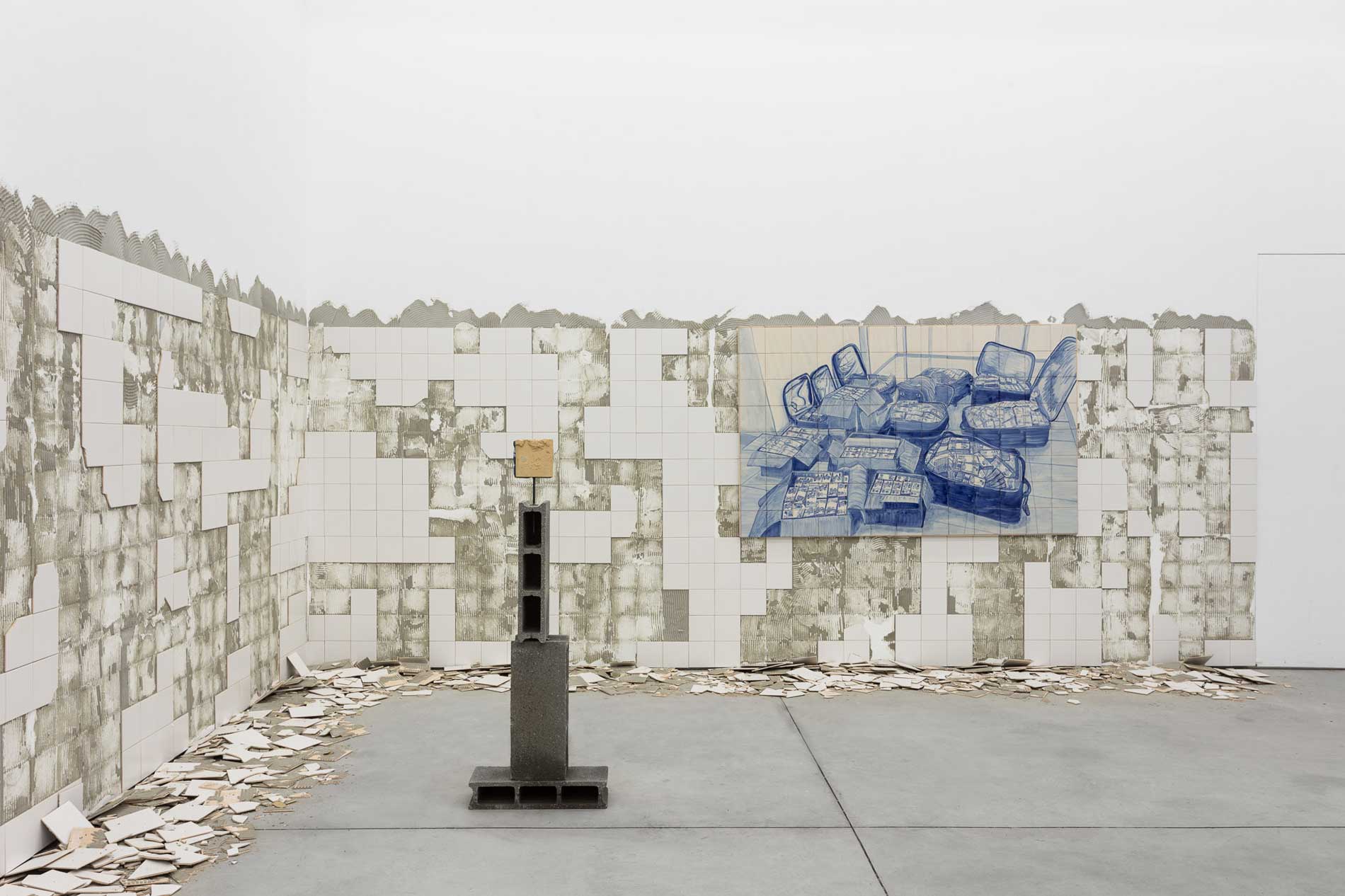
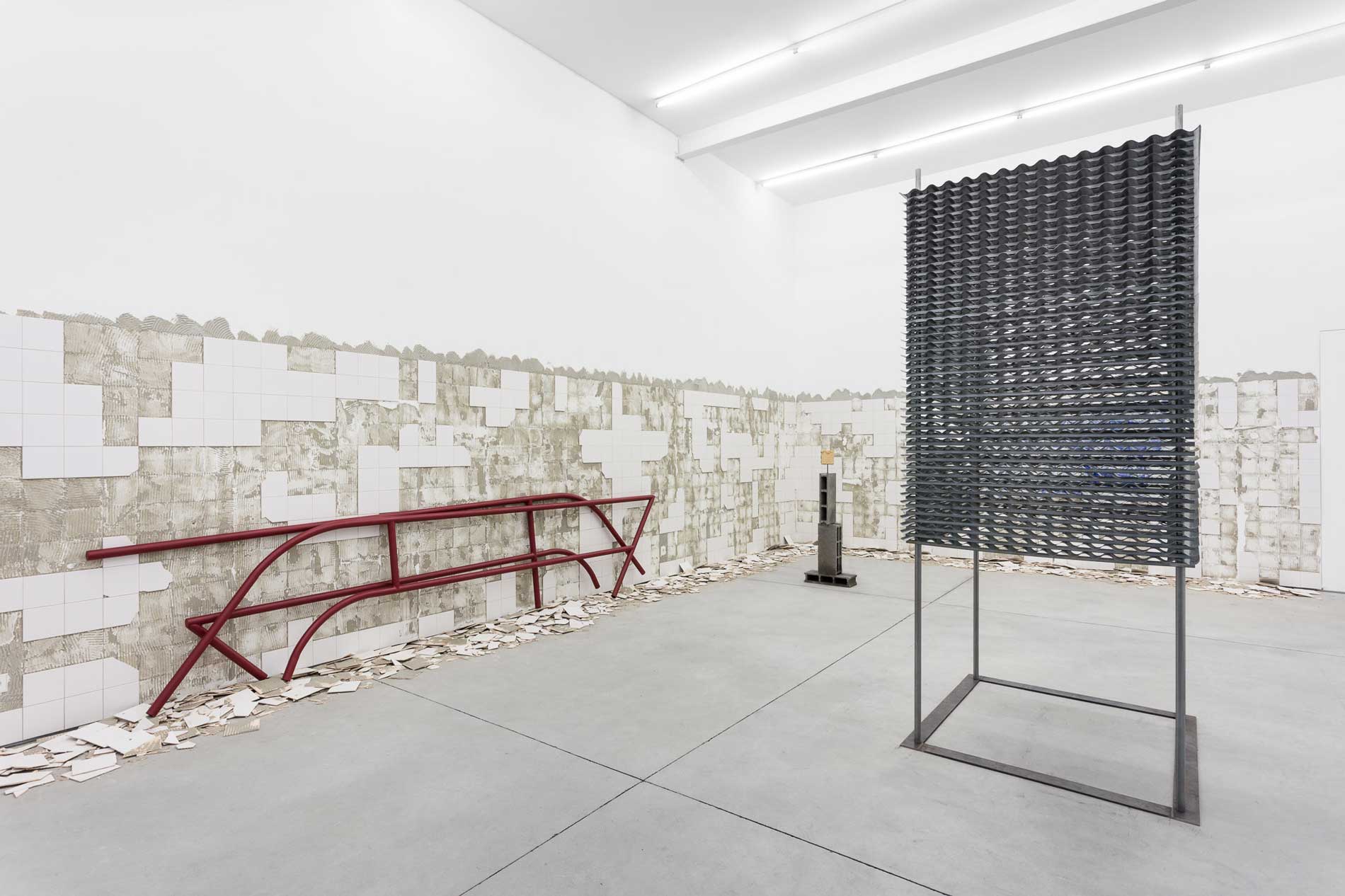
Marcelo Cidade, Banheirismo, 2018. Bruno Murias Gallery, Arco Art Fair, Madri. Courtesy of the artist.
MC: Yes, there is another aspect, too: what he (the artist) represented was not real. He represented an ideal of reality that aligned with the king’s vision of power; otherwise, it wouldn’t be there. You have a whole history embellished and designed to please a political and social class. This deconstruction only happens later with Caravaggio, who challenges conventional aesthetic norms.
GD: Velázquez (as well).
MC: Velázquez, that’s it, to distort and question the power of the Crown.
GD: And it’s fascinating because there’s this aspect in painting of idealizing reality. We see this in Dutch paintings from the 17th century, particularly in still life compositions or floral arrangements. Often, the plants depicted were never actually together in reality. As the artist painted, the plants would wilt, and they would be replaced with fresh ones. In the end, the painting captures different moments in time, an amalgamation of still lives from different times. All of this pursuit of achieving the “beautiful.”
There is also temporal questioning that is directly intertwined with space. The relationship between time and space affects how we inhabit and experience life. I believe it is one of the greatest forms of power: the control of time. When you condense and structure time universally, synchronized in a manner where everyone adheres to the same perspective, you then stop seeing alternative temporalities and modes of existence. This creates layers and niches of imprisonment.
MC: Do you view architecture as a tool of social control? Or do you think that the status quo has used architecture in a manipulative way to exert control and art is similarly intervening to foster new ideologies? Or could it be that we are conspiring to challenge Western architectural paradigms?
GD: I think that both architecture and art, when lacking criticality and the imagination to consider alternative ways of inhabiting or existing, merely serve as representations of power. They become tools for disseminating information and maintaining historical control, thereby perpetuating the status quo. I believe that art also exercises a very clear economic power relationship, as you said, organizing markets and thoughts. Like architecture, it plays a crucial role in constructing history, so it’s no coincidence that it’s a place of dispute, right? Because disputing the narrative of art is to contest a narrative of historical concretization that endures. The same applies to architecture in the construction of spaces. From a “Foucauldian” perspective, architecture exerts a controlling influence over bodies and the organization of society. Both art and architecture can converge in critical thinking strategies because architecture engages in imaginative exploration as much as art does. It is powerful.
MC: Yes.
GD: I believe that the production timelines for architectural and artistic works are vastly different. Artists often engage in more spontaneous processes. The construction process in architecture can take years and relies on numerous factors including the number of people working the project. Even though artists may have more time to develop their work, they can often produce much faster. However, ultimately, both artists and architects are constantly working. For instance, as I walk down the street or when I do anything in life, I am constantly absorbing information that further develops my work. The same goes for artists.


Marcelo Cidade, Fogo Fato, 2021. Courtesy of the artist.
MC: When considering the “third world” context, architecture in Brazil is currently embracing a trend of global southern regionalism. Is there a way to conceptualize architecture that transcends the notions of housing or commercialism? I have this question, positioning art itself within this dilemma, positioning myself between the market and the institution, in a country where the institution is increasingly shrinking because it depends on the State, and the State no longer has the funds or the inclination to sustain institutional thinking. Production is increasingly driven by market demands, leading to divergent interests that may prioritize decoration or form over critical engagement with space, architecture, and society. Is there still a way to cultivate thought that is detached from market forces? Alternatively, can we transform the market?
GD: I think transforming the market is, in fact, not transformative, don’t you think? Because the market will always win. However, we had several good experiences in Brazil, especially during the 50s and 60s at the beginning of Modernism, like when Reidy(1) designed the Pedregulho housing complex in Rio de Janeiro, which were high-quality homes for public workers. The circumstances were vastly different back then when the State was overseeing it. Nowadays, it’s mainly driven by private initiatives, which complicates our situation significantly because every part of the city is perceived as a parcel of land. Each parcel comes with a price tag, and the entire dynamic revolves around consumption and the generation of surplus value. Wealth is tied to this production, unlike in art, the foundation of construction lies in the labor of workers who typically don’t share in the profits.
I have executed projects for various residences, including some that belong to people of a very high social level, let’s say representing about 1% of the Brazilian population. But this same client will negotiate the cost of labor, will look at a proposal and say, “Wow, this budget is expensive,” and then try to negotiate and ask the contractor to lower the price. The contractor lowers the value because he doesn’t want to lose the work and needs the job, and in the middle of the construction process, the client buys a TV for, I don’t know, R$50,000 or a stove for R$200,000.
MC: There is no class consciousness, right?
GD: No, there is no class consciousness. We are a reproduction of the fact that the labor force is a…
MC: A slaveholding nation.
GD: That’s it. Today, the construction of cities, linked to profit-maximizing models and parceling lots, stands in stark contrast to collective and collaborative approaches to urban development processes.It dramatically limits the possibilities of imagining alternative ways of living. How can we cultivate a more harmonious relationship with other life forms, including rivers and animals, connecting us to collective doing, which is the city. It’s strange because as architects, we find ourselves in an intrinsic relationship where our work is exchanged for financial value, which often translates into a market-driven dynamic of control. Private clients, more often than not, leverage architecture to assert their power. Consequently, they seek architectural designs that distinguish them in some way…
MC: As individualistic as possible.
GD: Yes. It represents him as belonging to a certain social class and signifies a different historical era compared to previous generations. Additionally, for this house, he will also require the work of an artist to demonstrate how he can intellectually distinguish himself from others. Ultimately, everything becomes a relationship of production and exchange.
MC: But where does the exchange take place? If there’s only the deprivation of space and the individualization of life, where is the space for this exchange to happen?
GD: There is no such exchange. I’m referring only to a financial exchange. The exchange of coexistence itself, which could be…
MC: Yes, the concept of coexistence, community, and exchange that would typically occur in what we refer to as public spaces, such as squares or parks, is dwindling in São Paulo. Even when these spaces do exist, they are often fenced, have restricted hours of access, or are monitored by private security guards who regulate who can enter and exit. How can individual freedoms persist in a place or space that is already predetermined, not for everyone? Are we becoming increasingly restricted? Or is it due to a justified cause, such as concerns about violence, crime, and the prevailing social anxieties surrounding the “other”?
GD: Which is the same thing.
MC: Which is the same thing. It’s the savagery of the world.
GD: It’s ironic because the same person who will live a private city life here, will experience the “public” infrastructure in Europe. They are making money here in São Paulo, viewing the city purely as a means of financial gain. At the end of the month, they travel to France to use the subway, ride bikes and electric scooters in the Netherlands, and marvel at how smoothly things operate, remarking, “Look at how well things work, it doesn’t work in Brazil”.
MC: Smoke weed in Amsterdam (laughs)
GD: (laughs) Right, you’re going to smoke weed in Amsterdam and think, “How evolved they are,” while forgetting the burden of colonization that has allowed this European state its identity, even the possibility of these public spaces. Here in Brazil, seeing the other as a threat is normalized. It is a reproduction of our historical organization of colonization, a historical process that we have never been able to deal with…

Affonso Eduardo Reidy, blueprint of the Pedregulho housing complex, Rio de Janeiro.

Marcelo Cidade, “Around a round around a round around a round around around”, 2019, Oslo Biennalen, Norway. Courtesy of the artist.
Marcelo Cidade, Irregulares, 2022, was exhibited at Praça Charles Miller, Pacaembu.
The project, in partnership with Contínua Gallery, was part of the Arpa fair program in São Paulo. Courtesy of the artist.
MC: Brazil is very violent, as we know. It was founded in violence. I think about my works, and in each piece, the idea of violence is present either objectively or subjectively. However, living in São Paulo means confronting violence directly or indirectly every day, whether through visual or noise pollution, encounters with inhumanity, or simply navigating through the Minhocão, where one might have to jump over a sea of sleeping bodies(2) just to reach the studio. This violence is part of everyday life. We accept it, and we normalize others’ misfortune because you see someone there starving; you ignore them and continue with your day. This reality deeply influences my artistic practice. While I’m here in the studio, I’m constantly creating pieces that address themes of violence or the deprivation of individual freedom. At the same time I am reflecting on how even the artist’s freedom, which should ideally be more expansive to deal with these issues, is in reality constrained.
Then, as I observe the work of the younger generation, I notice how their creativity is constrained as well exactly by the pervasive presence of fear and social confrontation in their daily lives. Despite it all there’s a palpable desire for change, with each individual seeking to make their own contribution towards transforming this reality.
GD: Yes, you have always placed yourself in an uncomfortable position, right? All your studios have enabled a very close relationship with the city, and this is a process that is intrinsically linked to your way of thinking and doing; anyway, I find it very powerful. The issue of younger artists is complex because there are a large number of people who have never had access to art…
MC: Art with a capital A, you need to make Art.
GD: Oh yes. But today, there are more inclusive institutional and public proposals that aim to diversify these accesses because, as we have already discussed, the visual arts in Brazil have historically been very much tied to a repetition led by a small economic elite.
MC: Exactly; it has always been a very elitist production. Focusing, for example, on the modernist movement, Tarsila do Amaral was the daughter of a farmer.
GD: Absolutely. I think there was a moment when we started to consider this art production questionable. However, I also believe that we lost our ability to engage in constructive criticism, haven’t we? That’s another subject already, but I believe there is more criticism in art than in architecture. Architecture has completely died.
MC: But you’re referring to Brazil, right?
GD: Yes, we are talking about Brazil. Access to the art structures proposed today also enables artists to advance economically, build networks, and cultivate relationships within institutions and the art market, breaking down the barrier of exclusive and elitist art.
For instance, what does it signify to create a painting in contemporary times that reimagines, or even replicates, a Renaissance perspective—a perspective that embodied a particular way of being and an ideal? How does this unfold today, especially within the context of a capitalist system? It’s a complex situation; we are all in the moment of rethinking these perspectives.
MC: I find it interesting to have a plurality of themes, colors, shapes, genders, and measures that deviate from a standard that was very similar ten years ago.
GD: And it’s very fast, isn’t it?
MC: Yes. I find this diversity intriguing at the outset of production, yet I still grapple with a sense of uncertainty about what to do with it. Not knowing where it will lead is also interesting because it becomes a bit scary when we think about production through a very determined process. When people have too many certainties, and I see that nowadays the certainties are much more about how the market deals with this young production, wanting to determine, shape…
GD: Scrutinize…
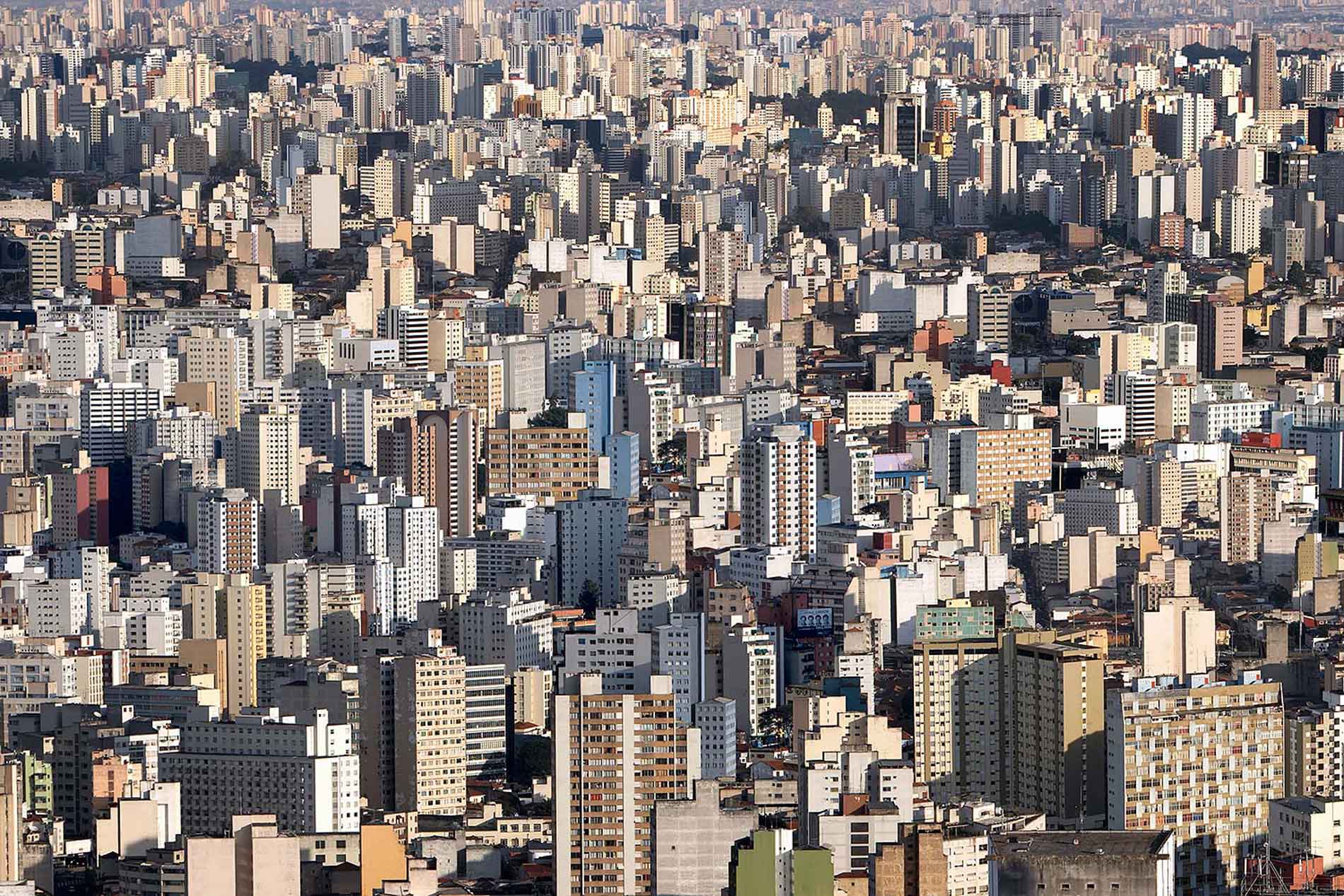
Marcus Lyon, BRIC II – Center of the city – São Paulo, 2008.

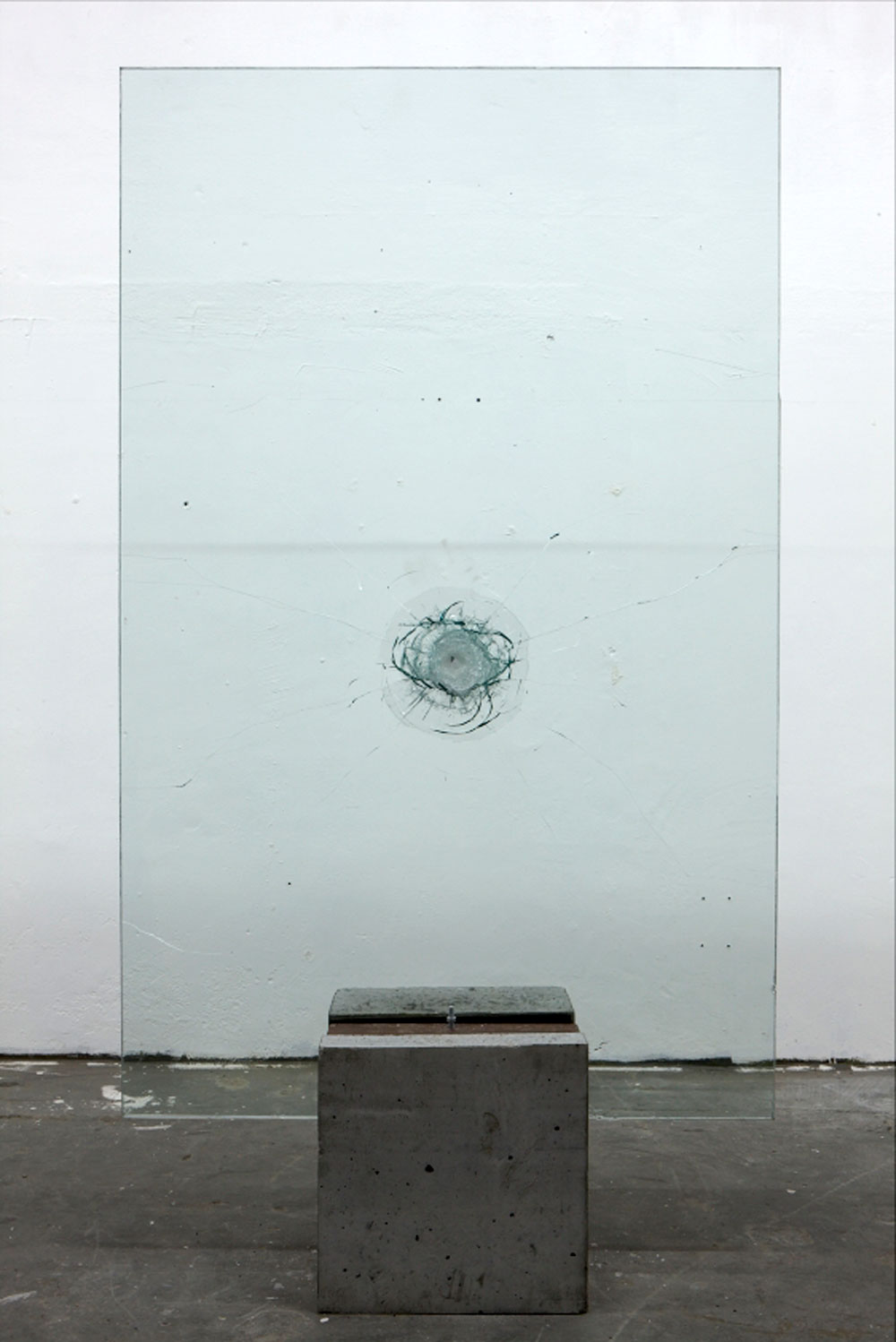
Courtesy of the artist.
MC: Exactly, we often find ourselves scrutinizing and downsizing artwork to accommodate the homes of newly affluent individuals who lives in compact apartments so they can’t own pieces larger than 60 x 60 inches, as anything larger would overshadow the sofa (laughs). That scares me a little, you know? The young artist does not realize that a one-by-one-meter painting is not a large painting. In reality, he would be referring to a ten-by-ten scale, reminiscent of the architectural scale prevalent in the 1950s. During this period, painters—predominantly white—sought to transcend the confines of traditional painting, urging the medium to infiltrate everyday life and break free from its formal constraints. It started with Hélio Oiticica(3), right? With the Parangolé (a type of vibrant cape or garment, embodying the idea of wearing color), he liberates color from the canvas, bringing it into physical space. He transports it to places like Rocinha (a community in Rio de Janeiro) and beyond, effectively taking the artwork off the wall. Oiticica then frees color and form from architecture, and that’s what’s super interesting about Hélio: this freedom to transmute the idea of art from the elitist part and say, “It doesn’t belong only here; this belongs to the world.” And bringing this thought to the world, the favela, Rocinha, and samba is to bring these supposedly marginalized manifestations into art. So, I believe he was among the first to invert the concept of inside and outside.
GD: I think this is something we’ll only grasp through a displacement of time, a more extended time. Critical thinking must always be somewhat restless because, without doubt, then there is no transformation.
MC: Indeed, as you mentioned, everything hinges on time to discern what will validate this artistic process, whether it’s merely dictated by the market or extends beyond its confines.
GD: Exactly, especially in this post-Bolsonaro moment (former President of Brazil, right-wing party). It’s something that came from institutions, and we realized how fragile things were.
MC: Certainly. There has been a notable deconstruction of left-wing ideologies during Bolsonaro’s government, facilitated by the proliferation of fake news and the strategic repositioning of the left as a perceived threat. The right-wing has demonstrated a formidable capacity to manipulate and co-opt the ideals of vulnerable populations, and justify the “world’s evil” with cultural production.
GD: Indeed, there has been a significant rupture in the hegemony of traditional leftist thinking. Events such as the COVID-19 pandemic have underscored the importance of access to communication channels. I am not thinking of a virtual relationship as a solely positive one, but trying to think of a path where people started to question more independently. Whether critical or not, discussions now occur among different audiences, bypassing the need for filtering through elitist leftist channels, which, in my opinion, often hegemonizes discourses. An intellectual discourse among individuals who have access to…
MC: … like translators for minority ideas. Nowadays, people no longer need these translators, as in Marina’s (Silva)(4) interview with Fernanda Torres(5), where the agenda was exactly this topic: we, left-wing whites, are confused. Because what would be our role in society today?
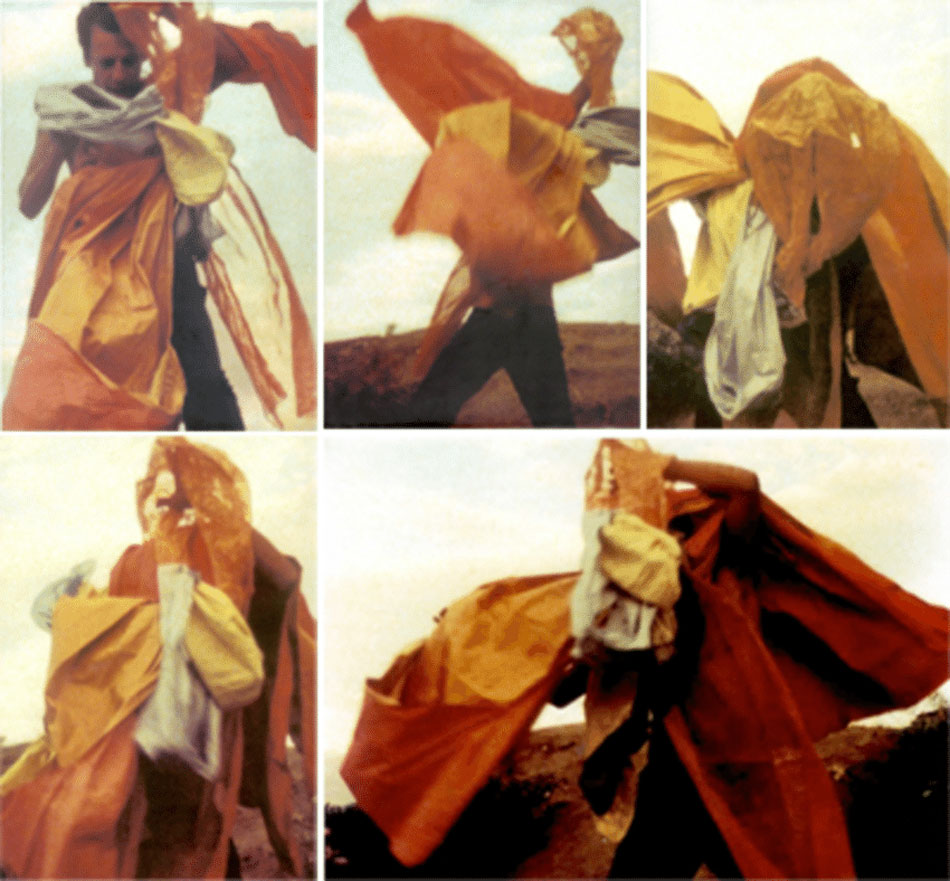
Hélio Oiticica com Parangolé P4 Capa n.º 1 (1964.) Stills of the film HO de Ivan Cardoso, 1979. Credit: THE MUSEUM OF FINE ARTS HOUSTON.
Hélio Oiticica The Body of Color. (Exhibition book) Houston, 2007.
GD: Exactly, there was a collapse. ? I think a great example would be Mano Brown(6), a musician who appeared in the 90s producing music but never went to Rede Globo(7) and had no music distributor.
MC: For sure. He refused to associate himself with Sony He was a truly independent artist. The songs were sold in a illegal way. In the ’90s, perhaps around ’96, I recall waiting at the bus stop in Vila Sônia and out of every ten cars that passed by, nine were blasting Racionais (a group led by Mano Brown from prison) on their boombox.
GD: (laughs), One day my aunt came with a Racionais cassette tape and asked if I had heard of this group. That was a big event for me. (laughs)
MC: (laughs) Yes, my life changed when I listened to Domingo no parque, Vida louca, Pânico na Zona Sul (titles of Racionais’ songs), so much so that the title of my next exhibition will be Pânico na Zona Sul, a tribute to Racionais, but also a questioning of this notion of what the South is, right? South of where? In the South in relation to my South or to the South of São Paulo? Or the South of Rio de Janeiro?
GD: South of the Equator,
MC: Exactly, South of the Equator? Because the sense of panic is everywhere (laughs), it’s not just in the South anymore.
GD: It essentially speculates and generates wealth without the production of tangible goods, leading to a relationship of abstraction where the “real” loses its significance. Have you heard about the prediction that the world’s first trillionaire will emerge soon?
MC: Seriously?
GD: Yes, in five years.
MC: Wow, can you imagine that? It’s already difficult to imagine the difference from 1 million to 1 billion. With 1 trillion dollars one can buy a country.
GD: This one person has more GDP than many countries in the world. And it’s a measurement of economic powers that override the State. It’s no wonder the State is increasingly becoming a “business counter.” It’s no wonder the Chamber and the Senate are lobbyists who are there. It’s no wonder that the democracy of the United States is based on war.
MC: They continue the colonial process in the most imperialistic way possible.
GD: Yes. Spread instability to sell weapons—a war industry.
MC: Can the decolonial process only happen when the arms factories are gone?
GD: Well, we will never be able to end that (laughs)
MC: (laughs)
GD: It will be tough! I think it’s easier to end the world. And then colonize Mars? Continue the same thought on another planet?
GD: I think we are living in a world with an imagination crisis, where the ability to envision and propose innovative ideas is noticeably deficient. We are somewhat a hostage to hegemony. No wonder indigenous peoples have been discussing this for centuries, right? There exists a stark differentiation between “humans” and “nature,” perpetuating a sense of disconnection and imbalance between the two. This relationship is not healthy. And many indigenous peoples have been talking about this for a long time, including the power of dreaming. It seems silly when you say it like this, “I’m going to sleep and dream of another world,” but there is a lot of power in that. I think there is a layer that we need to access, a sensitivity.
MC: Oh really? Look, we haven’t developed anything. (laughs)
GD: We are perpetuating this hegemony even in our perception of time. We can challenge the simplification embodied by the clock: a device composed of numbers arranged in a circle with a pointer driven by gears. By condensing time into this array of symbols within a mechanical contraption, we inadvertently constrain our imagination and limit the exploration of alternative perspectives. Consequently, we cease to question time itself, and its deeper implications remain unexplored.
MC: In rational thinking, correct?
GD: Yes. It’s as if we need to deconstruct a bit as if we shared a loss of memory. This hegemonic time reflects an idea of progression, starting from an idea of linear evolution about events and “achievements.” Which is a mistaken image because, from my point of view, the concept of “evolution” is a constant process of differentiation and not of achievements and “historical victories.” Imagination and desire motivate shifts, and these shifts anticipate major catastrophes or herald genetic alterations that metamorphose or even prefigure what lies ahead.
The other day, I watched a documentary stating that 99% of all species that have ever inhabited Earth are now extinct. What we learn from species that exist today – from the mite on your pillow to giraffes – represents 1% of the total diversity that once existed. In other words, 99% are extinct, including plant species. Therefore, it would be highly imaginative to reconsider this other 99% of species.
MC: Of course!
GD: Because there isn’t a centralized database or hardware where all information is stored, I think the conventional approach of collecting information as a linear, historical narrative is flawed. In nature, it is almost an inverted process of memorizing, imprisoning, and therefore detaining… which is a bit of the idea of culture: detaining knowledge. I believe in the power of mystery, of sensitivity. This is a great philosophical imagination. And I think art has this role too. I believe that art possesses the power to engage with life and living beings with freedom and potency. It’s not surprising that art is a place of dispute. It is a battleground for power because it is where you maintain the imprisonment of ideas.
MC: Yes, in fact, ideas have to become dangerous again.
GD: I think that’s precisely it. Dangerous for those in power, right? The idea of breaking this relationship.
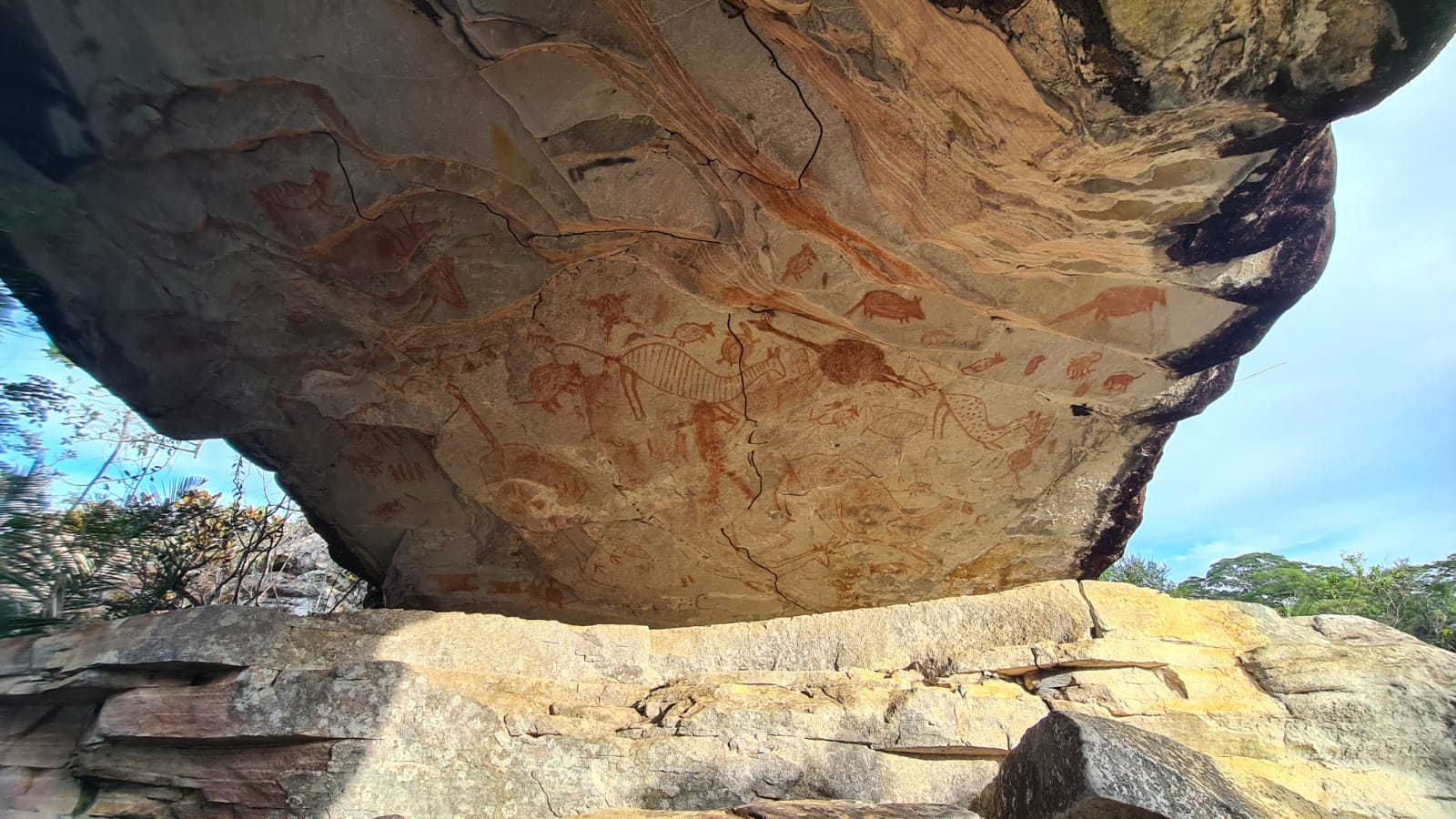
Gustavo Delonero, photo of cave paintings dating back approximately 10,000 years. Vale do Jequitinhonha, Serra do Espinhaço, 2021. Courtesy of the artist.


Marina Lima, Cave painting, Vale do Jequitinhonha, Serra do Espinhaço, 2021. Courtesy of the artist.
MC: Just today, I observed how Instagram obscures and restricts the visibility of artists’ accounts. They are limiting access and exercising control, resulting in artists feeling isolated and facing censorship when they use their voices and communicate their messages. I saw on Claire Fontaine’s Instagram that two of her works were censored because they did not comply with “guidelines.” No reason was given. So you see that the so-called freedom of social media, in fact, has only one interest. It’s not a broad range of interest, like a medium that gives voice to different ideas. We can also see artists who support the ceasefire against Gaza and take a position against Zionism being completely devastated and censored. Or what is happening in Germany, too?
GD: Exactly. They censored exhibitions and artists who were already contracted with projects happening. The same thing happened now at Documenta in Kassel.
MC: I think there will come a time when artists won’t have freedom anymore.
GD: I agree. Because someone like Elon Musk, who bought Twitter and made a post praising (Javier) Milei and who defends that “the hero of the world is the entrepreneur because he is the one who generates jobs.” As if everything belonged to him…
MC: How scary (laughs), so scary!
GD: (laughs) Without thinking beforehand where does this raw material come from? And the whole relationship. Suppose you had a printer in the office, bought fake ink from Mercado Livre (Brazilian online shopping app), and accidentally blocked the printer. You then take it to be fixed but the price to fix it is too hight, therefore not worth it. So now you need a new printer. That one will have to be thrown away. So it’s an equipment built under a combination of components: labor from various countries, for example, and in a short period of time, it’s something that will turn into garbage that you can’t use later…
MC: Wow (laughs), tying a knot in Marx’s historical materialism, which is precisely about that…
GD: Exactly. You don’t participate in any part, or rather, you participate in pieces of production.
MC: I also question how artistic work today is undervalued and discarded precisely because of this fear of the voice of a profession that has the freedom of action to express contradictory positions. Does this also happen in architecture?
GD: I believe it does but in a masked way.
MC: Less direct, maybe?
GD: Architecture is intricately linked to the economic framework of society, serving as a foundational element that manages a multitude of tasks, thus contributing to its complexity. Within these tasks, each one has its own interests, but among all these interests, the most perverse are those who are thinking exclusively about making a profit. Those who cannot think of architecture as an instrument of empowerment or emancipation and of building coexistence and people’s emancipation. As a society, we need to imagine spaces that allow other forms of occupation, living, experiencing, and enhancing exchanges. This also reminds me of the space of algorithms and their control. How do you manage bubbles versus giving space for new events?
MC: In this new public space, right?
GD: Yes. Unfortunately, São Paulo is a very cruel city, where you have no relationship with nature. It’s hard to escape the city. Controversially, there is social complexity, a very powerful effervescence of ideas, but reflecting on the current moment, I think we have never had so many people getting sick, right? It’s due to the difficulty of venting. It’s strange. We are living in a complex moment.
MC: Certainly! I concur. I believe we’ve made some progress in our discussion. Thank you for the engaging conversation, Gustavo.
GD: Thank you, Marcelo.
Marcelo Cidade, O Propagador, 2023, Lisboa, Portugal. This untreated steel tube structure is a faithful replica of the typical advertising objects found in the urban landscape of São Paulo, the city where the artist resides. By bringing the object into the exhibition space, Cidade reverses its reliable function, replacing the informative sign with an iron plate where only the textures and patina of the material are present. Like a gesture of suppression, the structure is now rendered useless, falling into the obsolescence of emptiness, and its original function of materialistic propagation is then reconfigured into a non-function of self-propagation of nothingness – a loop of emptiness and superficiality – we would even say, an advertisement for the very material of propagation. Courtesy of the artist.
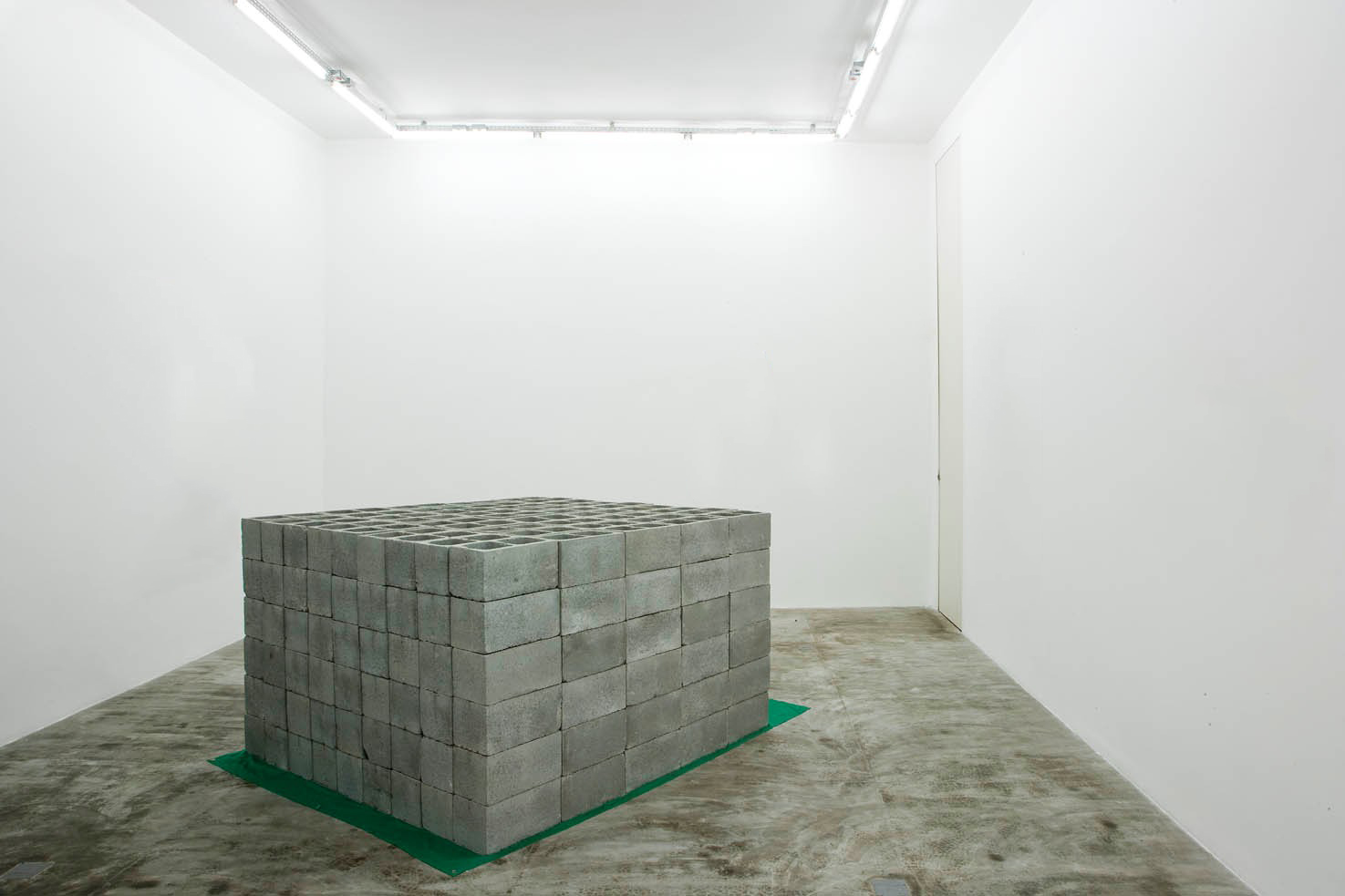
Marcelo Cidade, Luto e luta, 2008. Courtesy of the artist.
To know more about Marcelo Cidade: @cidade
To know more about Gustavo Delonero (Estúdio Vão): https://vao.arq.br/index.html
1. The Pedregulho Housing Complex (Conjunto Residencial Prefeito Mendes de Moraes, commonly known as Pedregulho) is an apartment complex and planned community in the Benfica neighborhood of Rio de Janeiro, Brazil. It was designed by the architect Affonso Eduardo Reidy (1909-1964). The project was planned in 1946 to house lower-paid civil servants of the city, which was then the Federal District of Brazil. Work commenced on the complex in 1949 and inaugurated in 1951/1952.
2. Homeless people living underneath Minhocão, a large viaduct in São Paulo.
3. Hélio Oiticica (1937–1980) was a Brazilian visual artist, sculptor, painter, performance artist, and theorist best known for his participation in the Neo-Concrete Movement, his innovative use of color, and what he later termed “environmental art,” which included Parangolés and Penetrables, like the famous Tropicália. Oiticica was also a filmmaker and writer.
4. Maria Osmarina Marina da Silva Vaz de Lima (1958), known as Marina Silva, is a Brazilian politician and environmentalist. She is currently Brazil’s Minister of the Environment and Climate Change (since 2023). She is also the founder and former spokeswoman for the Sustainability Network (REDE).
5. Fernanda Torres (1965) is a Brazilian film, stage and television actress and writer. She was born in Rio de Janeiro, the daughter of the Oscar-nominated actress Fernanda Montenegro and the actor Fernando Torres.
6. Pedro Paulo Soares Pereira (1970), better known by the artistic name Mano Brown, is a Brazilian rapper, music producer and founding member of the hip hop group Racionais MC’s, along with Ice Blue (Paulo Eduardo Salvador), Edi Rock (Edivaldo Pereira Alves) and KL Jay (Kleber Geraldo Lelis Simões). In 2008, Rolling Stone chose the 100 greatest artists in Brazilian music; Mano Brown was 28th. His debut solo album Boogie Naipe was nominated for the 2017 Latin Grammy Award for Best Portuguese Language Contemporary Pop Album.
7. TV Globo, or simply Globo and alternatively as Global), formerly known as Rede Globo, is a Brazilian free-to-air television network, launched by media proprietor Roberto Marinho on 26 April 1965. Globo is the largest commercial TV network in Latin America and the second-largest commercial TV network in the world behind the American Broadcasting Company and the largest producer of telenovelas.
Hero image: Marcelo Cidade, Amor e ódio a Lygia Clark, 2006. Courtesy of the artist.

